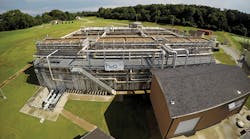It's just chips, software, Ethernet and transfer control protocol/Internet protocol (TCP/IP). Even its name, Industrial Internet of Things (IIoT), is more complicated than necessary. It's just Internet—and whatever anyone wants to pile on top to communicate, move data, crunch numbers, perform tasks, make better decisions and optimize processes.
Granted, all kinds of network protocols and software tools are sprouting like dandelions to make the IIoT easier for users to access and process their data. However, several key concepts and strategies are proving to be the most useful, differentiating themselves from less helpful methods, and streamlining users' efforts to gain the most value from their Internet connections.
Basics from scratch
While it can no doubt streamline existing processes, IIoT's latest tools and added connections can provide even more assistance to new applications, and lessen some of the extra labor that's always needed to get them up and running.
For instance, the City of Decatur, Ark., recently implemented the state's first membrane bioreactor (MBR) plant for treating residential, commercial and industrial wastewater, but it needed a supervisory control and data acquisition (SCADA) system that could provide real-time data to help manage the new facility. It consists of 13,956 tags, 908 alarms, 42 variable frequency drives (VFD), 37 screens, seven clients, six PLCs, three workstations including a 55-inch touchscreen, and a centralized server with a relational database, which usually logs about 2,100 tags per second.
Learn more on how to optimize with the Industrial Internet of Things in the series.
The water utility treats about 5 million gallons per day (gpd), but its only previous controls included pushbutton panels and an indicator lightboard, and these manual devices weren't connected to other departments. There was no line-of-sight for how much waste was treated in real-time from the utility's sources, and its staff had to rely on error-prone manual data for invoicing residential, commercial and industrial sources.
"The utility also had a SLC 505 PLC, but it had no HMI, so all reporting and trending was manually entered onto an Excel spreadsheet. This included flow and pressure information, and analytical data such as dissolved oxygen, nitrates, ammonia and turbidity," says Paul Bartlett, director of services and automation at H2O Innovation in Québec City, Canada. "The utility previously used sequence batch reactors (SBR) with aeration tanks, and other engineering firms advised adding more SBRs. However, due to limited real estate, H2O was asked to help retrofit the plant with an MBR built on top of its existing infrastructure as a way to double its capacity without increasing its footprint. MBR can treat water more efficiently, which was also needed because a new industrial plant that processes 750 chickens per minute wanted the utility to treat its water."
Bartlett reports MBRs still employ anaerobic and anoxic zones, but they add pumps and a filtering membrane. This meant no tanks had to be added or removed in Decatur, so the utility's infrastructure revamp and MBR facility only cost $10-15 million. Of this, H2O and system integrator Automation Station in McAllen, Texas, contracted for about $5 million to implement the membrane and filtering equipment. This included about $250,000 for a new SCADA system, which employs web-based Ignition, V7.9, software from Inductive Automation. Hardware for the MBR alone included 25 VFDs from Danfoss and Eaton, four PLCs from Rockwell Automation, two servers, and 250 I/O points, each with 40-60 tags for setpoints, thresholds, alerts and alarms. One pressure I/O and transmitter was installed to pull in data, perform add-on instructions (AIO), and allow multiple I/O operations. AIO is a PLC function that works with Rockwell Automation's PlantPAx software and associated tags (Figure 1).
"This was a big HMI/SCADA project with about 15,000 tags, 100 screens and 12-14 reports for compliance, performance and health of the membrane, and lab data that had to generated daily, weekly or monthly," says Bartlett. "Flow, pressure and energy consumption data were pulled automatically. We started commissioning in January 2019 and finished in May 2019."
The city's modernized water treatment plant lets its operators and managers make real-time decisions based on better data. It also eases regulatory compliance because Ignition generates the discharge monitoring reports (DMR) it submits to the state. Plus, the utility can work with neighboring, municipal utilities to temporarily divert water in high-demand situations to further avoid overflows. With its new SCADA system deployed, it can also accept waste from a local factory that needs real-time data to meet its regulatory obligations.
Simpler screen-making
David Rojas, president and senior automaton engineer at Automation Station, explains that HMI/SCADA projects used to be more difficult, time-consuming and costly because developers and clients traditionally had to buy SCADA software, historians, reporting tools and other components separately, and integrate their disparate devices, software and network connections. "This process is a lot easier now because Ignition puts everything into one web-based platform," says Rojas. "We have the power to develop scripts in Python for automatically creating tags by pulling information from PLCs, and even pushing data back to PLCs. For instance, if any analog instruments are connected to the PLC, we can scan its data type, map it to a tag based on our custom user defined types (UDTs), and make them readily available in the tag tree. We can also create templates on the Ignition side that leverage these tags onto those templates. This simplifies making multiple screens, which also means fewer potential errors. Mapping and creating relationships for individual tags used to take a lot of time and labor, and generate mistakes. Using automated scripts to do this work for us makes it feasible to scale our development for a project like the MBR and reduce costs."
Thanks to its reusable templates, scripts and tags, Bartlett estimates that developing its SCADA system for Decatur's new MBR project took about half as long as a similar project without these tools. "Previously, an end user that needed to adjust an alarm time would have to call the PLC programmer for a site visit," he says. "Now, the operations guys can do it with a few clicks."
Rojas reports that when SCADA is assisted by IIoT connections, it gives the water utility and other applications added benefits, such as the ability to relay and consult images and other content. "Users can upload pictures of instruments, pumps and other equipment, call them up onscreen, and show actual devices and the manuals for them," he says. "We can also add live weather feeds, including radar and precipitation for the previous hour, and store this historical information in a database that we can use later to make comparisons. For example, we can track turbidity and how it's been impacted by recent rainfall, and check how plant performance will be affected. This could tell us we need to store more water, and not send as much to the plant to avoid overflows, or indicate we need to dose more chemicals, or show how we can avoid future problems by checking other results over the past several years."
[sidebar id=2]
Rojas adds that IIoT can also enable SCADA users to make graphs of all their lab data, put it next to their process data, and make side-by-side comparisons much more quickly. "Instead of manually making one Excel trend graph per day, we can now generate and update one every second. These show us trends that can indicate the location, reason and roots cause of big pressure spikes, stuck or broken valves, or plugged membranes," he says. "Finally, H2O also developed a more flexible MBR plant with flexible PLC code that helps solve a longtime problem in the membrane industry. Because most MBRs are custom-designed, membranes in the cassettes they use are all different, so it can cost fives times as much to replace them as when they were new due to refitting/re-piping and using different PLC code. However, H2O's cassettes can accommodate using any other manufacturer's membranes in its system, which also helps users seek more competitive bids."






